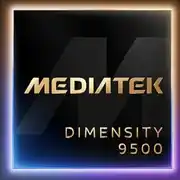MediaTek Dimensity 9500

MediaTek Dimensity 9500 — fast, cool, and clearly aiming for the top
Dimensity 9500 is MediaTek’s flagship on TSMC’s 3-nm N3P node. The “all big cores” concept stays, but the focus shifts to steady single-thread speed, console-style ray-traced graphics, and strong on-device AI.
Key points at a glance
-
CPU (Armv9.3): 1× C1-Ultra + 3× C1-Premium + 4× C1-Pro; larger caches (up to 16 MB L3) for responsiveness without frame-time dips.
-
GPU: Arm Mali-G1 Ultra (MC12) with accelerated hardware ray tracing and frame generation up to 120 FPS in RT scenes.
-
Memory / storage: LPDDR5X up to 10,667 MT/s; UFS 4.1 “4-lane” for faster sequential transfers and quicker AI model loads.
-
Connectivity: 5G Sub-6 (FR1) with up to 5CC CA; Wi-Fi 7 (TBTC, peak 7.3 Gbps); Bluetooth 6.0 (dual engine).
-
Cameras / video: sensors up to 320 MP, video up to 8K60, plus 4K120 with EIS and “cinematic” 4K60.
-
AI: NPU 990 (2nd-gen Gen-AI Engine) + ultra-efficient CIM block; on-device image generation up to 4K and snappy agent-style tasks.
What’s better vs Dimensity 9400
Faster prime core and more cache. L3 grows to 16 MB (9400 had less), and the new “ultra core” boosts single-thread and short, heavy bursts—app launches, photo processing, exports.
Next-step storage. Swaps UFS 4.0/MCQ for UFS 4.1 4-lane: quicker AI model loading and media I/O, fewer “hiccups” in multitasking.
Noticeably stronger graphics. Mali-G1 Ultra MC12 raises peak FPS and pushes ray tracing much harder; frame upscaling/generation up to 120 FPS in RT scenes.
Camera/video headroom. Sensor support climbs to 320 MP; video ceiling moves to 8K60 plus 4K120.
Comparison with competitors
Versus Snapdragon 8 Gen 4
-
Memory / storage. Both use LPDDR5X; 9500’s ace is UFS 4.1 “4-lane”, while 8 Gen 4 more often ships with UFS 4.0. For AI apps and heavy games that means smoother loads and fewer micro-stutters.
-
CPU profile. 9500 goes “1+3+4” with big caches; 8 Gen 4 typically “2+6”. Qualcomm is traditionally strong in short bursts, but 9500 closes the single-thread gap via a higher-clocks prime core and bigger L3, holding frequency longer.
-
GPU / RT. Adreno is famous for peak throughput and drivers; 9500 counters with robust hardware RT and frame generation up to 120 FPS. In non-RT titles engine optimization decides; with RT enabled, 9500 often feels steadier on frame pacing.
Versus Exynos 2500
-
Process and CPU. Both on 3 nm, different philosophies: Exynos runs 10 cores with an emphasis on efficiency and long-haul stability; 9500 doubles down on “all big cores” and responsiveness. 9500 tends to be quicker in short bursts, Exynos is very stable over sustained background loads.
-
AI. Exynos pushes impressive “paper” TOPS; 9500’s NPU 990 + CIM combo shines in real, prolonged offline scenarios (assistants, generation) without cooking the battery.
-
Cameras / video. Top modes are broadly aligned—8K60, advanced HDR/portrait chains; 9500 stands out with flexible 4K120 and wide sensor support up to 320 MP.
Who should pick this chip
-
Power users and creators. Fast single-thread + UFS 4.1 “4-lane” = snappy imports/exports and calmer multitasking.
-
Mobile gamers. Ray-traced titles benefit: higher RT performance, frame generation up to 120 FPS, and cooler hands thanks to N3P and larger caches.
-
Mobile filmmakers. 4K120 with EIS and “cinematic” 4K60 open creative options; headroom up to 8K60.
-
Battery-first users who hate throttling. N3P + larger caches + smarter schedulers reduce power spikes and keep performance steady in hand.
Basic
GPU Specifications
Connectivity
Memory Specifications
Miscellaneous
- FLAC
- HE-AACv1
- HE-AACv2
- MP3
- H.265
- AV1
- VP9
Benchmarks
Phones with Dimensity 9500




Comparison of Devices with Dimensity 9500
Compared to Other SoC
Related SoC Comparisons
Share in social media
Or Link To Us
<a href="https://cputronic.com/soc/mediatek-dimensity-9500" target="_blank">MediaTek Dimensity 9500</a>

